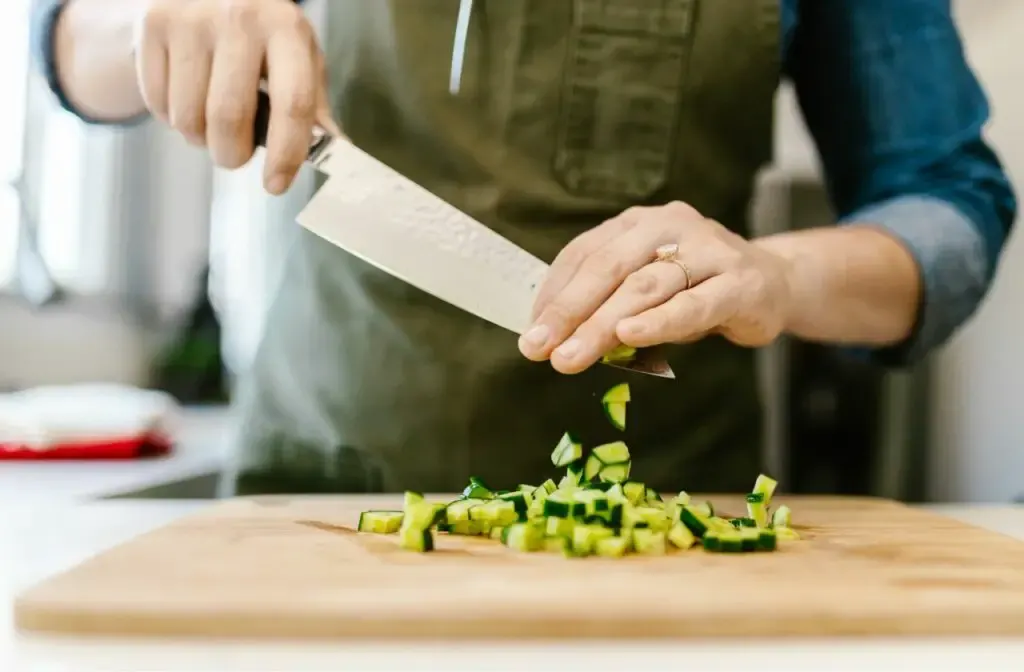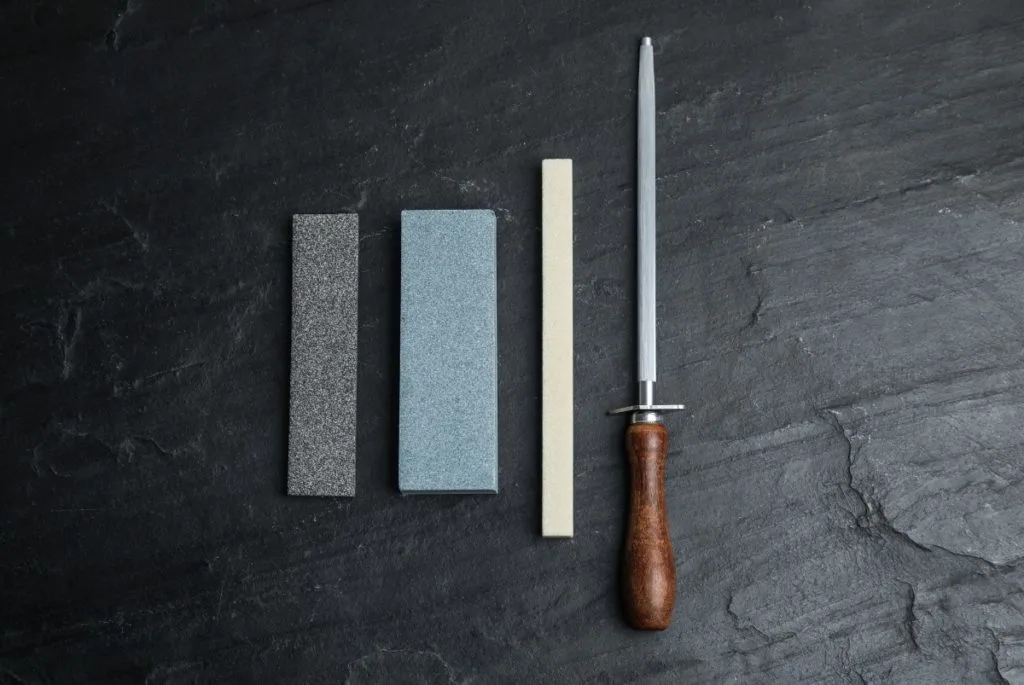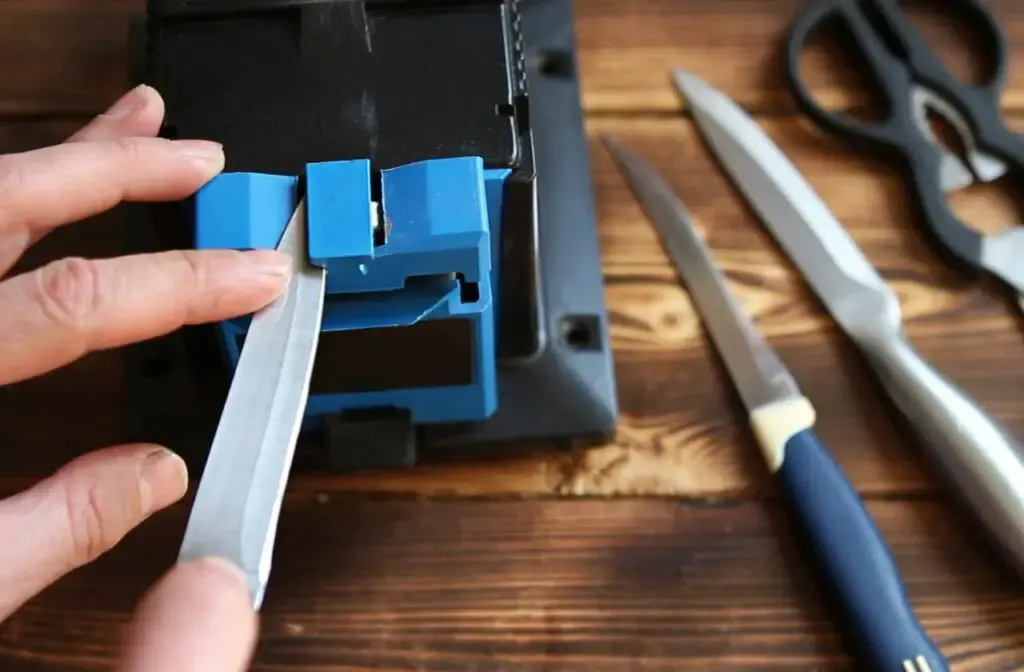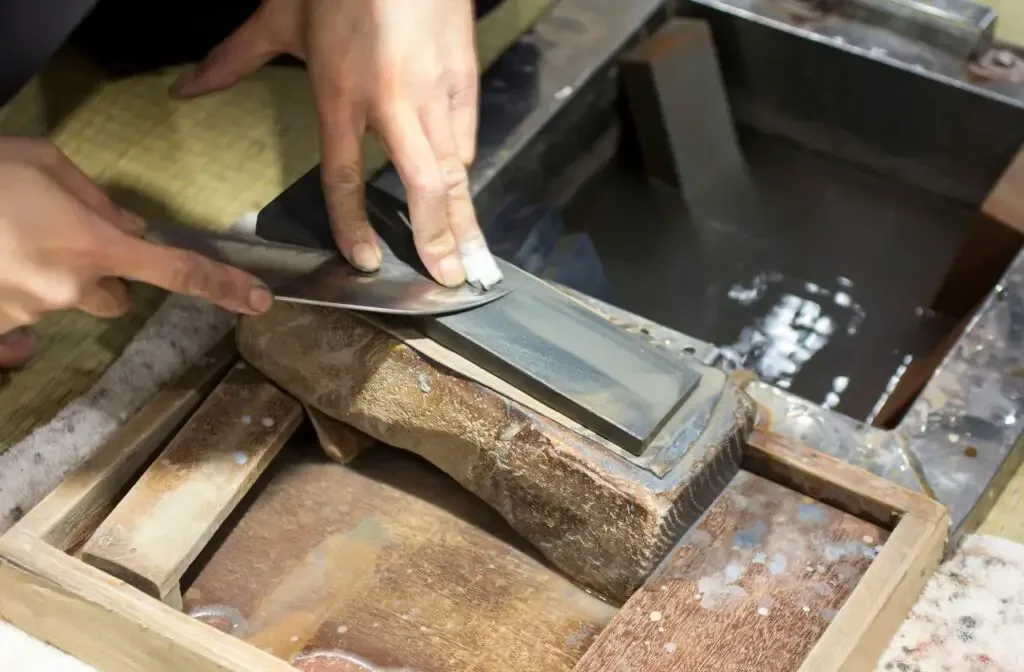As an Amazon Associate, we earn from qualifying purchases with no additional costs for you.
Many knife owners are unsure about knife sharpening, which causes them to leave knives longer than they should before sharpening. Sharpening is an important part of knife care, but it also benefits several aspects regarding knife use. We will examine the four main reasons to sharpen your knife before use.
Your knife should be sharp and honed before use. The four main reasons this is important include the following.
- Safety for the knife user.
- Preservation of the knife’s cutting edge.
- Prevent crushing the item being cut.
- Saving time by making rapid, clean cuts.
Keeping a knife sharp should be a major priority for any knife you have and use regularly. Neglecting this important aspect can have consequences for you as the knife operator and result in unnecessary wear or damage to the knife itself. How often should you sharpen your knife?
If you are interested in checking out the best whetstones for your knives we recommend and use you can find them by clicking here (Amazon link).

Why Is It Important To Sharpen A Knife Before Use?
Knives are designed to cut, which implies they need a sharp edge to perform their intended function correctly! There are several implications when the knife’s edge is not at its prime. Many of the problems associated with a dull knife can be remedied by sharpening the knife before use.
The X main reasons it is important to ensure your knife is sharp before using it include the following.
1. Knife Operator Safety
A dull knife presents a danger for the person using the knife. The main concern is the additional pressure required to cut through an item when the knife is dull.
The additional pressure or force that needs to be applied when using a dull knife can cause the blade to slip or unexpectedly push through the item and cut the person using the knife.
A dull knife may struggle to cut through the item you intend to cut, but when the blade slips, a dull knife may still be sharp enough that it is capable of inflicting a serious cut on your skin. The knife’s point could also suddenly push through the item being cut and stab your hand.
A sharp knife will slice through the material being cut with considerable ease compared to a dull knife. This gives the knife user more control over the slicing action since less force is required to make the cut. This makes sharp knives significantly safer to use than blunt knives.
2. A Sharp Knife Prevents Damage To The Edge When Slicing
When processing ingredients, you generally cut on top of a cutting board. If the knife is dull, extra force must be applied to get the knife to cut through the ingredients.
When a dull knife is pushed through the ingredients, it is difficult to control the blade at the end of the cut, and the knife’s edge is slammed into the cutting board’s surface.
While most modern cutting boards are made from materials designed not to cause a problem for the knife’s cutting edge, they will cause damage if the knife hits it with force.
A sharpened knife will glide through the item being cut with ease, requiring less force from the knife user. This gives the knife user more control over the knife allowing the cut to be performed cleanly and gently without the knife’s cutting edge slamming into the cutting board, further damaging the edge.
TIP: The right tools to sharpen your knives properly can make all the difference to learning the skill and maintaining your knives. Check out the must-have tools for sharpening your knives:
3 Must-Have Tools To Sharpen Your Knife Properly (Answered)
3. A Sharp Knife Won’t Crush What It’s Cutting

It is of particular importance in the kitchen to use a sharp knife when preparing food. This is not only part of your safety protocols, but a dull knife can affect the outcome of the dish you are preparing.
A dull knife must be pushed through the ingredients with force. The additional pressure can crush the ingredient, causing the juices to come out of the item and end up on your cutting board. This crushing can result in a loss of flavor and cause the ingredient to dry out during the cooking process due to the liquid loss.
Crushed ingredients can also negatively affect the presentation of the food. No diner wants to have a mushy slice of tomato in their salad over a nice, firm, juicy slice of tomato.
In contrast, a sharp knife will slice through ingredients without crushing them, retaining the juice, moisture, and texture of the ingredients, thereby improving the quality of the final dish.
This crush rather than slice principle does not only apply to the kitchen but to other knife uses as well. As an example, using a dull bushcraft knife to cut a braided line will crush the strands, causing the braids to separate after the cut.
A sharp knife will slice cleanly through the line, causing less separation of the braids preventing the line from unraveling before you seal the end with heat.
4. Sharp Knives Save Time
Sharp knives will slice quickly and efficiently through the item being cut. This allows for the fast processing of items rather than wasting time hacking through the material.
This time saving is especially important in professional kitchens where dishes need to go out on time as well as look good.
TIP: As much as we would like them to, our kitchen knives do not last forever! Check out the most common signs you need to replace your kitchen knife in the article below:
5 Signs You Need to Replace Your Kitchen Knife + How Often
Should You Sharpen A Knife Every Time You Use It?

The term sharpening means different things to different people, but sharpening means a very specific process to knife people.
It is not necessary to sharpen a knife every time you use it, but your knife must be sharp every time you use it. Hone the knife on honing steel or a leather strop before each time you use it. Depending on use, sharpening should only be necessary every 4 to 8 weeks.
Many people unfamiliar with knife terminology use the term sharpening to refer to honing and sharpening. However, these are two different procedures from a knife person’s perspective, although both make the knife sharp.
Honing a knife removes little to no material from the knife’s edge but rather re-aligns the cutting edge to restore the knife to ultimate sharpness. Thus, if the knife requires it, the edge can be honed each time before you use it.
Sharpening implies a more aggressive repair or reconditioning of the knife’s edge and should not be performed every time the knife is used.
TIP: Are you looking to buy a new whetstone? Check out our recommendations (we personally use the first three ones):
Our PRO choice whetstones combo (Amazon links):
- Fixing stone: Whetstone SHAPTON Ceramic KUROMAKU #320
- Sharpening stone: Suehiro CERAX soaking whetstone: Medium #1000
- Finishing stone: Whetstone SHAPTON Ceramic KUROMAKU #5000
Our budget choice (Amazon link): Sharp Pebble Extra Large Sharpening Stone Set
TIP: When people start sharpening their own knives, they find that some knives are hard to sharpen. Check out the main reasons why some knives are hard to sharpen in the article below:
5 Reasons Why Some Knives Are Hard To Sharpen & What To Do
Should I Sharpen My Knife Every Day?

A knife sharpened every day will experience excessive wear on the blade’s edge due to the abrasive sharpener wearing the steel away.
A knife can be honed every day but should not be sharpened every day. The knife should only be sharpened when needed to restore the edge or if the knife has become very dull. Sharpening should only be necessary every 4 to 8 weeks in heavy-use knives but at even longer intervals for low-use knives.
Most good-quality knives will hold their edge well and will not require frequent sharpening so long as the knife is cared for correctly, used as intended, and the knife is honed frequently.
BTW: If you want to know more about Japanese and other knives and their sharpening, check out the books listed above. These books are recommended by professional sharpeners and knife makers (Amazon links):
- Japanese Kitchen Knives: Essential Techniques and Recipes
- The Knifenerd Guide to Japanese Knives
- Knife: The Culture, Craft, and Cult of the Cook’s Knife
- Sharp: The Definitive Introduction to Knives, Sharpening, and Cutting Techniques, with Recipes from Great Chefs
Knife Maintenance Through Sharpening

Regular knife sharpening and the use of proper sharpening techniques are critical aspects of good knife maintenance. Remember that sharpening is not just honing an edge but also preserving the knife and keeping it usable for as long as possible.
Microscopic View of a Knife Edge
At the microscopic level, a sharp knife edge is a marvel to behold. It appears smooth, continuous, and free from major imperfections. In contrast, a dull knife reveals a different story. Its edge is riddled with irregularities, nicks, and imperfections, which impede its cutting efficiency.
Imagine viewing both under a microscope: the sharp knife would resemble a straight line, while the dull one would look like a rugged mountain range.
Metal Fatigue and Edge Roll
Every time you use a knife, it undergoes stress. Over time, this stress can cause the fine edge of the knife to roll to one side or develop tiny bends, a phenomenon known as edge roll. This is one of the primary reasons knives lose their sharpness.
Additionally, the metal undergoes fatigue. Just as we tire after continuous work, the metal, at a microscopic level, experiences wear and tear, leading to tiny chips and bends.
Importance of Material Hardness
The material of the knife plays a pivotal role in its sharpness retention. Harder metals, like certain high-carbon steels, can maintain a sharp edge for a longer duration. However, they might be more brittle and susceptible to chipping.
Softer metals might not retain sharpness as long but are generally more malleable and less prone to breakage.
Common knife materials such as stainless steel, carbon steel, and ceramic each come with their unique set of advantages and challenges concerning sharpness.
The Physics of Cutting
A sharp knife is not just a chef’s delight but also a masterpiece of physics. When you cut with a sharp knife, you’re applying force over a very fine edge, concentrating the pressure on a minuscule area.
This means you require less force to make a cut. Furthermore, a sharp edge reduces friction between the blade and the material being cut, ensuring that the knife glides smoothly and efficiently.
In contrast, a dull knife increases friction, requires more force, and results in jagged, imprecise cuts.
Conclusion
A sharp knife is not only safe to use, but it is also a pleasure to use and more efficient for its intended task. Using a dull knife, in contrast, is dangerous and frustrating.
While it is not necessary to sharpen your knife every time you use it, the knife must be sharp before you start.
This means you should put a sharpening protocol in place to make sure your knives are always sharp. That way, a quick honing or a few passes across a strop before use will have your blade ready and primed for action!
TIP: Whetstone sharpening requires skills that are only acquired by practice and experience, but we all have to start somewhere. Check out the step-by-step guide on how to sharpen a knife with a whetstone:
Step-By-Step GUIDE: How To Sharpen A Knife With A Whetstone
